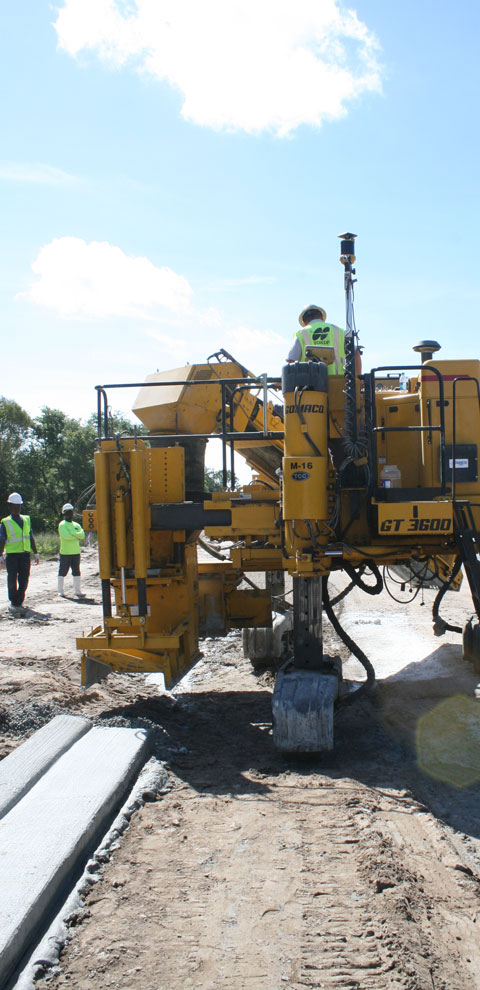There and Back Again
To understand why the intersection of SR-82 and Daniels Parkway was the ideal candidate to debut the first CFI in Florida, one need only see the exodus of vehicles leaving the city of Lehigh Acres every morning, then heading back in every afternoon. According to Jacob Amann, Ajax Paving GPS specialist, backups, extending for a couple miles are not uncommon, resulting in regular delays, lost productivity and L.A.-like stress levels.
“During peak periods, cars are literally pouring out of or into Lehigh and the intersection of SR-82 and Daniels simply wasn’t built to handle that load,” he said. “Florida DOT looked at a number of possible solutions to the problem, but liked what the CFI offered in terms of keeping more traffic moving at any given time.”
A new concept to all but a few parts of the country (Louisiana, Utah, Texas, and Missouri), a continuous flow intersection is a highway engineering design which seeks to minimize drivers’ time spent in the left turn lane waiting for other segments of the intersection to cycle through their phases. Instead, cars wanting to turn left are siphoned away into a lane referred to as a “bay,” beginning 600 feet before the intersection, and simply make their left turn when oncoming traffic get a green light to go straight. By eliminating the wait for a green arrow, traffic turning left is segregated from those vehicles heading straight — without the need for a ramp, bridge, or fly-over. Right turns will be handled in right lane slip lanes that merge with the main lane downstream of the intersection. The net result is through-traffic gets more “green time” and capacity through the intersection is dramatically increased. In fact, in a CFI, 70% of traffic is moving at any given time.
“As high-profile as this project is, our owner and upper management still felt it was the right job to put our GNSS skills to the test,” said Amann. “We made that commitment — and then some — and the results have been impressive. This is a two-lane road increasing to four lanes then up again to six. The maintenance of traffic alone could be a nightmare, so we’ve created models for all the traffic switches, and then used the GNSS-equipped dozers and graders to make it all happen.”
Curb: the Enthusiasm
Fulfilling its vow to go “all-in” on the CFI job, Ajax utilized GNSS technology in virtually every facet of the project, including tracking quantities from a nearby borrow bit, milling the existing surfaces, and doing it all without pounding a stake. They then took it a step further.
“We actually made it a prerequisite for our subcontractors to embrace GNSS and that wasn’t always an easy request to fill,” said Amman. “But, in doing so, we found the companies who recognize the value these solutions bring to the jobsite. Ft. Myers-based Tincher Concrete Construction, who did all of our curb and gutter work, is one of those companies. They had no prior GPS experience, yet they’ve been able to hit the ground running and have posted some impressive production numbers. The same holds true for other subcontractors as well.”
From the point of view Tincher Concrete, the initial move to GNSS was fraught with uncertainty. Stringline is, after all, the visual reference upon which concrete paving professionals have grown to rely. Remove that, it’s been thought, and nothing is certain, according to John Strine, Tincher’s superintendent for curb.
“I won’t deny it; going stringless was scary at the beginning,” he said. “For the first time in my career, I had no visual reference when setting curb. But we know that this is the way things are going, so we felt it would be a good move for us to learn the technology, grow as a company and get a jump on the competition. We are using Topcon Millimeter GPS on a GOMACO GT-3600 curb machine and, thanks largely to the help from Lengemann and Topcon, got comfortable with both fairly quickly. In fact, we’ve made some outstanding progress, placing nearly five miles of curb so far and doing as much as 7,400 feet in a single day.”


















